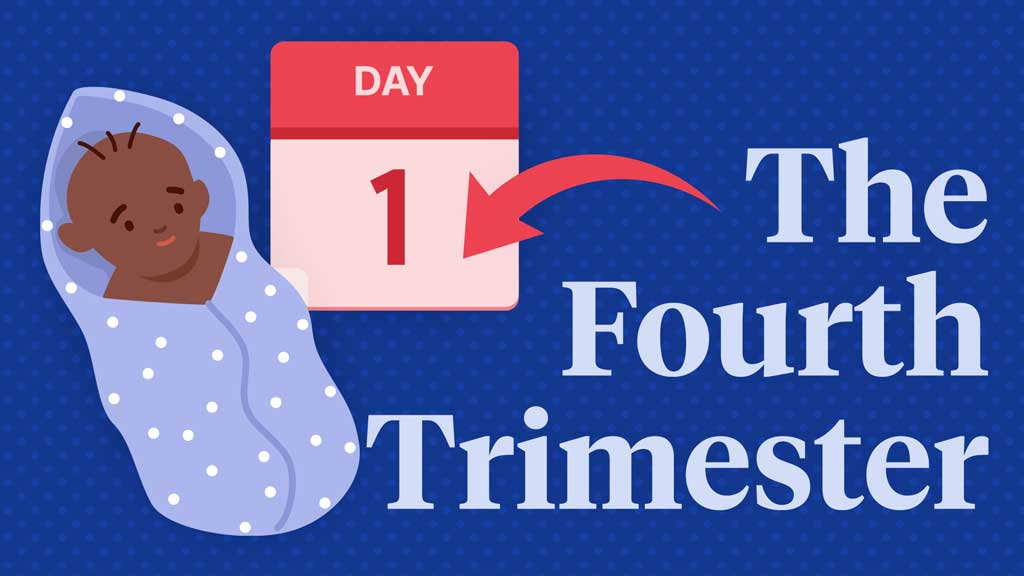The first few months after birth are essential for establishing family wellbeing.
The first 12 weeks postpartum, also known as the fourth trimester, should be seen as a continuum of pregnancy and an important period of recovery and family adjustment (Verbiest et al. 2018).
Typically a time of great joy, the early postpartum period is also a time of significant challenge as new parents adapt to hormonal and physical changes, recover from delivery, endure sleep deprivation and adapt to shifting family responsibilities (Spelke & Werner 2018).
Given the significance of all these changes, Goldfarb (2021) asks why monitoring, support and anticipatory guidance are not offered with the same intensity as during the antenatal period, as most parents would benefit from much closer follow-up during the fourth trimester.
Postnatal Advice and Assessment

The fourth trimester can be a time of great vulnerability, especially for new parents, who tend to focus all of their attention on their newborns, often to the detriment of their personal health and wellbeing (Pregnancy, Birth and Baby 2023).
The key considerations when assessing early postnatal health include:
Bleeding
This should diminish in the weeks following birth, gradually changing in colour from bright red to a brown lochia before ceasing entirely. Patients should be advised to report the presence of any blood clots and reassured that afterpains might be more noticeable and bleeding heavier in the early days while breastfeeding.
Elimination
For those who have had a vaginal birth, grazes or tears to the skin around the vagina can cause pain when passing urine. Reassurance should be given that this is normal, and simple self-help techniques should be suggested, such as drinking plenty of water to dilute the urine and pouring lukewarm water over the perineum to reduce any stinging sensation whilst urinating. Advice should also be offered at this time to help the patient avoid constipation, especially if haemorrhoids are present.
Stitches
Basic wound care advice should be given to those who have stitches following a caesarean birth, perineal tear or episiotomy.
Breastfeeding
Many people find the changes in their breasts in the early postnatal days to be concerning, whether they are breastfeeding or not. For those who choose to breastfeed, this is one of the most important areas where ongoing skilled support is needed.
Pelvic Floor Exercises

Stress incontinence is a common problem in the immediate postnatal period. Although most people learn how to perform pelvic floor exercises in antenatal classes, encouragement should be given for regular practice in the early days following delivery.
Sex
Physical recovery, exhaustion and hormonal changes can affect sexual desire after childbirth and patients often need reassurance that it’s entirely normal to ease back into a sexual relationship at their own pace. This is also an important time to discuss future methods of contraception.
Managing Expectations
Supporting the entire family as they adapt to change and encouraging realistic expectations about the challenges of early parenthood is another vital, though often overlooked aspect of fourth-trimester care.
(RANZCOG 2024)
Improving Fourth Trimester Care
Spelke and Werner (2018) suggest that even though physical checks are of the utmost importance, there can be a disconnect between clinical considerations such as signs of infection, and the concerns of patients, who may experience significant distress from symptoms that are considered to be a ‘normal’ part of parenthood, such as sleep deprivation, discomfort and emotional changes.
Many researchers, including Tully et al. (2017), have been exploring this practice gap. Their suggestions for improving postpartum care include enabling more convenient, holistic care that is culturally appropriate, and which addresses the interrelated health issues that are most important to women.
Written or multimedia aids such as handouts, videos or websites can also be helpful postpartum resources after discharge. As Spelke and Werner (2018) note, this is a request that is often voiced in focus groups, reflecting the need for additional support for new parents.
The fourth trimester is also a period of healthcare transition, as patients shift from pregnancy-centred care to interpregnancy and then primary care services. However, this transition can be marked by poor coordination of care between providers, which can leave new parents feeling unsupported.

Creating a Postnatal Plan
Creating a postnatal plan can be just as valuable as creating a birth plan, especially for single or first-time patients. As Goldfarb (2021) describes, there are many online resources available to help parents do this. Just as with a birth plan, actively planning for optimal postnatal care can be an efficient way of helping parents express their concerns and get the support they need.
As Savage (2020) says, if planning for birth is good practice, then planning for the fourth trimester is also good practice, and the more specific or detailed the plan is, the more helpful it is likely to be.
Ideally, parents should start to formalise their plan no later than the third trimester. Their plan should be meaningful, realistic, achievable, action-specific, anticipate barriers and include reinforcement. Perhaps most importantly, a fourth trimester plan should also include information on how to access additional resources such as community support groups.
Social support within the person’s local community is essential in the fourth trimester, as it can make the transition into parenthood easier, less stressful and more enjoyable. Cornish and Dobie (2018) also believe that this topic warrants further research, as there can be significant differences in the need for social support between inexperienced primiparous and experienced multiparous parents.
As Savage (2020) says, the fourth trimester is characterised by a myriad of profound changes that affect the physical, emotional, social, and spiritual needs of the parent as they adjust to parenthood.
Perhaps, as One for Women (2019) suggests, the reason why the fourth trimester is often called the ‘silent’ trimester is that it is under-represented and poorly understood, leaving many people feeling forgotten as they embark on the most challenging transition of their life.
Topics
Further your knowledge
 Free
Free Free
FreeReferences
- Cornish, DL & Dobie, SR 2018, 'Social Support in the “Fourth Trimester”: A Qualitative Analysis of Women at 1 Month and 3 Months Postpartum', The Journal of Perinatal Education, vol. 27, no. 4, viewed 28 March 2025, https://www.ncbi.nlm.nih.gov/pmc/articles/PMC6491158/
- Goldfarb, IT 2021, 'The Fourth Trimester: What You Should Know - Harvard Health', Harvard Health Blog, 6 April, viewed 28 March 2025, https://www.health.harvard.edu/blog/the-fourth-trimester-what-you-should-know-2019071617314
- One for Women 2019, A New Approach to Delivering Care in the Fourth Trimester, One for Women, viewed 28 March 2025, https://web.archive.org/web/20200302031550/https://www.oneforwomen.com.au/blog/a-new-approach-to-delivering-care-in-the-fourth-trimester/
- Pregnancy, Birth and Baby 2023, What is the Fourth Trimester?, Healthdirect Australia, viewed 28 March 2025, https://www.pregnancybirthbaby.org.au/what-is-the-fourth-trimester
- The Royal Australian and New Zealand College of Obstetricians and Gynaecologists 2024, The First Few Weeks Following Birth, RANZCOG, viewed 28 March 2025, https://ranzcog.edu.au/womens-health/patient-information-resources/first-few-weeks
- Savage, JS 2020, 'A Fourth Trimester Action Plan for Wellness', The Journal of Perinatal Education, vol. 29, no. 2, viewed 28 March 2025, https://connect.springerpub.com/content/sgrjpe/29/2/103.abstract
- Spelke, B & Werner, E 2018, 'The Fourth Trimester of Pregnancy: Committing to Maternal Health and Well-Being Postpartum', Rhode Island Medical Journal, viewed 28 March 2025, http://www.rimed.org/rimedicaljournal/2018/10/2018-10-30-obgyn-spelke.pdf
- Tully, K, Stuebe, A & Verbiest, S 2017, 'The Fourth Trimester: A Critical Transition Period With Unmet Maternal Health Needs', American Journal of Obstetrics and Gynecology, vol. 217, no. 1, viewed 28 March 2025, https://www.ajog.org/article/S0002-9378(17)30498-2/fulltext
- Verbiest, S, Tully, K, Simpson, M & Stuebe, A 2018, 'Elevating Mothers’ Voices: Recommendations For Improved Patient-Centered Postpartum', Journal of Behavioral Medicine, vol. 41, no. 5, viewed 28 March 2025, https://link.springer.com/article/10.1007/s10865-018-9961-4
 New
New 
